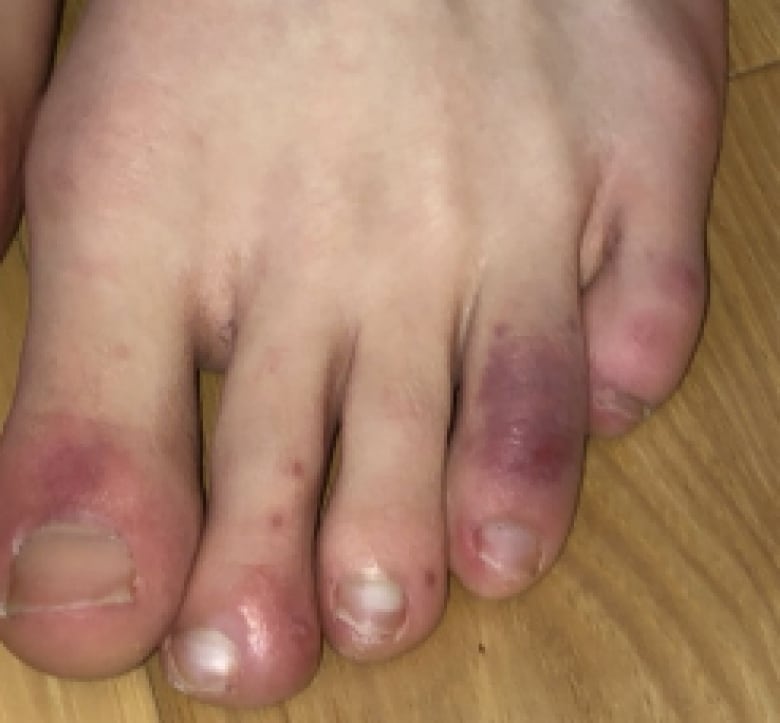What doctors and parents should watch for when COVID-19 affects children, including 'COVID toes'
Discoloration that resembles frostbite should trigger self-isolation

The COVID-19 illness is not hitting children in Canada or other countries as hard as adults, but doctors who care for children are on the lookout for unusual symptoms, including "COVID toes."
In a study set to be published online in the journal Pediatrics, researchers in China found that of 2,135 cases reported in January and February, only about six per cent of the children's cases were severe or critical compared to nearly 19 per cent for adults.
The Public Health Agency of Canada's data show a similar trend of few paediatric cases among the population, with five per cent of positive cases being under 19 years of age.
Dr. Charlotte Moore Hepburn, director of medical affairs at the Canadian Paediatric Society (CPS), said physicians are rapidly sharing new ideas as different presentations of the infection come to light.
Only a very small percentage of children who test positive require hospitalization. That should be very reassuring for parents and families.- Dr. Charlotte Moore Hepburn, of the Canadian Paediatric Society
"Only a very small percentage of children who test positive require hospitalization," Moore Hepburn said. "That should be very reassuring for parents and families."
As case reports emerge, it is important for health-care providers, patients and families to allow the information to be scrutinized scientifically by experts to make sure they're understood, Moore Hepburn cautioned.
To that end, when the CPS saw that pediatricians and family physicians were increasingly seeing children present with red, blue or purple discoloration of toes and sometimes fingers, the society sent an alert to its members.
"Sometimes, these lesions have no associated symptoms. Sometimes, they're hot and painful," Moore Hepburn said. "Sometimes, the children are otherwise well, and sometimes, they present with mild respiratory symptoms that would be concerning for COVID-19."

The skin discoloration resembles frostbite. It isn't a cause for concern and resolves on its own, she said.
"There's been an association with children who present with these discoloured what we call COVID toes and actual COVID-19."
But it's important for doctors to be aware that the condition may be a sign of COVID-19 to identify cases, trigger self-isolation and ensure their close contacts are aware that they've been in contact with someone who has COVID-19, Moore Hepburn said.
Unlike other respiratory disease
Dr. Jeffrey Pernica, head of the pediatric infectious diseases division at McMaster University, studies and treats infections, such as COVID-19 and influenza. He expects the vast majority of children with COVID-19 to do well and recover at home.
Why children are largely spared from the worst manifestations of the disease is the subject of scientific interest in many countries, with several hypotheses circulating but no answers yet.
WATCH | An unusual symptom called COVID toes
"COVID-19, in contrast to every other respiratory disease, seems to be spread less by children than by adults," Pernica said.
He said two possibilities include:
- Younger children have had exposure to other common cold type coronaviruses and gain some degree of immunity.
- Children have different immune systems than adults that are less likely to be revved up and "spin out of control."
The observations and hypotheses could have implications as some provinces, such as Quebec, cautiously prepare to send children back to school.
Prime Minister Justin Trudeau expressed some concerns Tuesday about sending his own children back to school.
"I'd want to know what the school was planning on doing, whether the desks were going to be properly spaced, whether there would be plans at recess in terms of keeping people separated," Trudeau told reporters.

'We don't know'
A recent review published online in Lancet Child and Adolescent Health points out that COVID-19 modelling studies suggest that school closures alone would prevent only two to four per cent of deaths, much less than other physical distancing measures.
Pernica said he's pleased people aren't assuming that keeping schools closed forever is the responsible thing to do. "It needs to be done in a reasoned way based on the epidemiology of the region."
He's also watching for more information about a rare but severe inflammatory syndrome that medical experts in Britain and Italy are investigating among infants who arrived in hospital with high fevers and other symptoms.
"We don't know how many cases there are. We don't know if it's really an increase from what you would expect, and we certainly don't know if it's linked to COVID," Pernica said.
For instance, sepsis is the consequence of widespread infection, which can lead to organ failure and intensive care.
In serious cases of COVID-19, doctors say children have the same symptoms as adults. If a child has a high fever, coughing and trouble breathing, then they should be rushed to hospital.
WATCH | The gold standard for handwashing:
With files from CBC's Christine Birak


